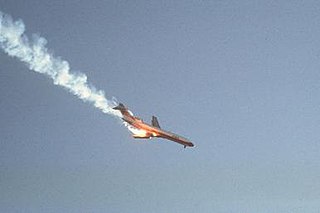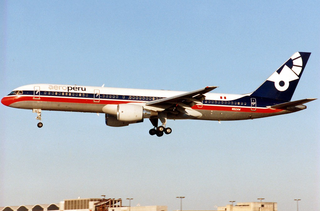
Lloyd Aéreo Boliviano S.A.M., was the flag carrier and principal airline of Bolivia from 1925 until it ceased operations in 2010. Before its demise it was headquartered in Cochabamba and had its main hubs at Jorge Wilstermann International Airport and Viru Viru International Airport. Founded in September 1925, it was the second oldest airline in South America after Avianca and one of the oldest airlines in the world.

Pacific Southwest Airlines (PSA) Flight 182 was a Boeing 727-214 commercial airliner, registration N533PS, that collided with a private Cessna 172 light aircraft, registration N7711G, over San Diego, California, at 9:01 am on Monday, September 25, 1978. It was Pacific Southwest Airlines' first fatal accident, and the deadliest air disaster in Californian history.

Aeroperú Flight 603 was a scheduled flight from Miami International Airport in Miami, Florida, US (KMIA), to Comodoro Arturo Merino Benítez International Airport in Santiago, Chile (SCEL), with stopovers in Quito, Ecuador and Lima, Peru. On 2 October 1996, the Boeing 757-23A aircraft flying the final leg of the flight crashed, killing all 70 people aboard.
LATAM Airlines is an airline based in Santiago, Chile, and is one of the founders of LATAM Airlines Group, Latin America's largest airline holding company. The main hub is Comodoro Arturo Merino Benítez International Airport (Santiago), with secondary hubs in El Dorado (Bogotá), Jorge Chávez (Lima), Mariscal Sucre (Quito), and José Joaquín de Olmedo (Guayaquil) airports.

Eastern Air Lines Flight 66 was a regularly scheduled flight from New Orleans to New York City that crashed on June 24, 1975 while on approach to New York's John F. Kennedy International Airport, killing 113 of the 124 people on board. The crash was determined to be caused by wind shear caused by a microburst, but the failure of the airport and the flight crew to recognize the severe weather hazard was also a contributing factor.

United Airlines Flight 389 was a scheduled flight from LaGuardia Airport, New York City, New York, to O'Hare International Airport, Chicago, Illinois. On August 16, 1965, at approximately 21:21 EST, the Boeing 727 crashed into Lake Michigan 20 miles (32 km) east of Fort Sheridan, near Lake Forest, while descending from 35,000 feet mean sea level (MSL). There was no indication of any unusual problem prior to impact.

American Airlines Flight 383 was a nonstop flight from New York City to Cincinnati on November 8, 1965. The aircraft was a Boeing 727, with 57 passengers, and 5 crew on board. The aircraft crashed on final approach to the Cincinnati/Northern Kentucky International Airport located in Hebron, Kentucky, United States. Only three passengers and one flight attendant survived the crash.

The 1967 Hendersonville mid-air collision occurred when a Piedmont Airlines Boeing 727-22 and a twin-engine Cessna 310 collided on July 19, 1967 over Hendersonville, North Carolina, USA. Both aircraft were destroyed and all passengers and crew were killed, including John T. McNaughton, an advisor to Robert McNamara.

Alaska Airlines Flight 1866 was a regularly scheduled passenger flight operated by Alaska Airlines from Anchorage, Alaska, to Seattle, Washington, with several intermediate stops in southeast Alaska. The aircraft was a Boeing 727-100 with U.S. registry N2969G manufactured in 1966. On September 4, 1971, the aircraft operating the flight crashed into a mountain in Haines Borough, about 18 miles west of Juneau, Alaska while on approach for landing. All 111 people aboard were killed. The subsequent investigation found that erroneous navigation readouts led the crew to descend prematurely. No definitive cause for the misleading data was found. It was the first fatal jet aircraft crash involving Alaska Airlines, and remained the deadliest single-aircraft accident in United States history until June 24, 1975, when Eastern Air Lines Flight 66 crashed.

Iran Air Flight 291 was a flight from Mashad Airport to Tehran-Mehrabad Airport that crashed on January 21, 1980 during its approach to Tehran-Mehrabad runway 29 in foggy and snowy weather conditions, killing all 128 people on board. At the time, Iran Air Flight 291 was the deadliest aircraft disaster in Iranian history.

TAME Flight 120 was a Boeing 727-134 airliner, registration HC-BLF, named El Oro, operating as a scheduled international passenger flight between Quito, Ecuador and Cali, Colombia, with a scheduled stopover at the Ecuadorian border town of Tulcán. The aircraft crashed while on approach to Tulcán's Teniente Coronel Luis A. Mantilla International Airport on January 28, 2002. The pilot flew the approach incorrectly in reportedly foggy conditions, and the aircraft crashed into the side of the Cumbal Volcano, located near Ipiales, Colombia, at 10:23 in the morning. All passengers and crew were killed in the crash.

Iberia Airlines Flight 610 was a scheduled domestic passenger flight from Madrid to Bilbao, Spain. On 19 February 1985, a Boeing 727-200 operating the flight crashed into a television antenna on the summit of Mount Oiz in Biscay near Bilbao. All 141 passengers and 7 crew on board died. The crash is the deadliest aviation disaster in both Basque Country and Iberia history.

SAM Colombia Flight 501 was a Boeing 727-46 that crashed on May 19, 1993, killing all 132 on board. The aircraft collided with a mountain while on approach to Medellín, Colombia.

EgyptAir Flight 843 was a flight from Cairo International Airport to Tunis–Carthage International Airport. On 7 May 2002, the Boeing 737-566 on the route crashed into a hill near Tunis–Carthage International Airport. Of the 6 crew members and 56 passengers, 3 crew members and 11 passengers died, making a total of 14 fatalities.

Ariana Afghan Airlines Flight 701 was the flight involved in a fatal air accident on 5 January 1969, when a Boeing 727 with 62 people on board crashed into a house on its approach to London Gatwick Airport in heavy fog. Due to pilot error the flaps were not extended to maintain flight at final approach speed.

On January 9, 2011, Iran Air Flight 277, a Boeing 727 on a scheduled domestic service from Tehran to Urmia, Iran, crashed after aborting its approach into Urmia Airport in poor weather. Seventy-eight of the 105 people on board were killed. The official investigation concluded that icing conditions and incorrect engine management by the crew led to a double engine flame-out, loss of altitude and impact with the ground.

ADC Airlines Flight 86 was a Nigerian domestic flight operated by ADC Airlines from Port Harcourt to Lagos. On 7 November 1996 the crew of the Boeing 727-200 operating the flight lost control of the aircraft while avoiding a mid-air collision on approach; the aircraft crashed inverted at a very high speed, killing all 144 passengers and crew on board. Investigators determined the primary cause of the accident was an air traffic control error.
















